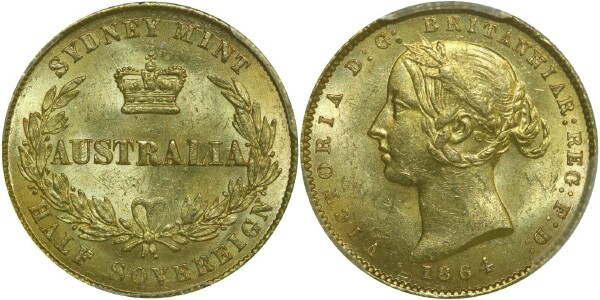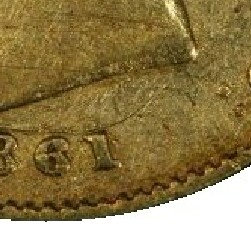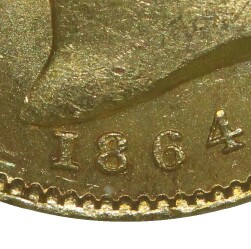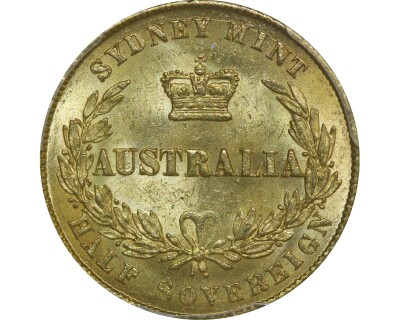Half Sovereigns of the Sydney Mint (1853 - 1869)
Introduction
The discovery of gold in the colony New South Wales in 1851 prompted a surge of immigration among prospectors seeking wealth in the new colony. While the lands were resource rich, the colony lacked the facilities to monetise the gold and the process in sending the gold to London for monetisation was slow and expensive. To help resolve this, on the 19th of Dececmber 1851 the Legislative Council of New South Wales petitioned Queen Victoria to establish a branch of the Royal Mint at Sydney

3.259 Million half sovereigns were struck in Sydney from May 1855 to 1869

Mintage figures were poorly kept by the Royal Mint Sydney for this period, for example, as can be seen from figure
Two distinct obverses were used for this type, the first being the Filleted Bust, or Type I Sydney Mint which features the bust of Queen Victoria with her hair tied into a filleted bun. The Type II or Wreathed Bust features the bust of Queen Victoria with her hair tied up with an oak wreath. The first type was struck from 1855 to 1856 while the second type from 1857 to 1869 though as mentioned above no pieces are dated after 1866. The Type II was also struck in 1855 and 1856 as patterns and a small number of 1855 dated Type II pieces were struck for circulation though these are extremely rare. Both obverses feature the legend: VICTORIA D. G. BRITANNIAR: REGINA F:D, Latin for Victoria, by the grade of God, Britain: Queen, Defender of the Faith.
Type I - Filleted Bust

The first business strike half sovereigns struck at the Sydney Mint were dated 1855 and 1856. Rather than using copper to harden the metal as the Royal Mint did, the Sydney Mint used silver. The reverse design featured a banksia wreath tied into a bow surrounding the word AUSTRALIA; these are positioned below a crown with the legend SYDNEY MINT and HALF SOVEREIGN encircling the entire design. This design was short-lived with the Sydney Mint reverting to the imperial shield design in 1871.
The first two years featured the filleted bust of Queen Victoria designed by James Wyon and is known as the Type I design. This design was replaced in 1857 by the wreathed bust of Queen Victoria or Type II design, designed by cousin Leonard Charles Wyon, son of William Wyon, engraver of the standard Young Head bust used since 1839. Patterns of the L.C. Wyon design were struck dated 1855 and 1856 with the 1855 dies used for business strikes, most likely in 1857 prior to being overdated to 1857.
Excluding varieties, overdates and the exceedingly rare 1855 Type II, the key date of the series is undoubtedly the 1855. The 1855 dated Type I half sovereign is very rare being survived by approximately 55 to 60 examples. The 1860 is also rare with an estimated 200 to 250 surviving examples.
The Sydney mint series is marked by low survival rates, likely due to the gold-silver alloy giving them a higher intrinsic value than their face value making it profitable to melt them down for their metal content. This gold-silver alloy continued for the entire series despite official protests to the Colonial Treasurer by Sydney based chemist Charles Watt with the Mint Master arguing that the extra value from the silver content was a decided advantage.
Out of the Type I series, only the 1856 can be readily acquired with lower grade examples being reasonably common and higher grade examples having survived through the Indian hoard. Survival rates of the 1855 are higher than the rest of the series at about 1 in 400 due to being a known rarity for much of its existence. This has meant that examples have survived regardless of condition thus leading to a higher proportion of problematic examples surviving when compared to the rest of the series which saw problem coins melted over the years. Despite the higher survival rate, the tiny mintage of just 21,000 has meant that the survival count is nonetheless very low.
Some 1856 half sovereigns were struck from a reworked 1855 die and can be identified by sharp corners on the 6 consistent with the 5 punch a tiny dot after the date as per figure

In addition to these, some 1856 half sovereigns were struck with a simpler reverse made from a reworked pattern die. The positioning and count of the berries are different along with the general shape of the design and a number of other minor features. These can easily be identified by a missing berry above L of HALF on the reverse and only 1 berry before the H of HALF like in figure


In addition to the 1855 and 1856 issues, four pairs of 1853 dated pieces were struck at the Royal mint London in order to seek approval for the colony’s Sydney mint design. Three of these pairs now exist in museums with the last in private hands.
Type II - Wreathed Bust

The Type II series was introduced in 1857 but as with most of the early Sydney mint issues, demand exceeded that which the mint could produce and due to the slow and expensive method for ordering replacement dies from London, the mint engaged in many improvised techniques for extending the life of the dies.
Due to the low pressure needed to strike gold coins, dies were more likely to wear out than crack and consequently the Sydney mint instead re-punched letters into the dies in order to extend their working life. This has resulted in a number of issues having re-punched letters, sometimes using the incorrect letter in place for example with the 1858 REG as RFG or SOVEREIGN as SOVRREIGN errors.
In addition to re-punching letters, dates were also overdated in order to continue using the obverse dies beyond their original date. The first overdated piece of the Wreathed Bust series was in 1857 when the 1855 pattern die bearing the L.C. Wyon bust of Queen Victoria was repunched with a 7 over the final digit in the date to produce a new 1857 die. These can be identified by the loop of the 5 protruding one of the right hand side of the base of the 7 as in figure

In addition to these overdates, a very small number of 1855 half sovereigns with the L.C. Lyon obverse are known to exist and considering the very low survival rates of the era, it should be considered no small feat for any to survive unless they were struck in higher quantities, probably around the 1000 mark. These were most likely struck in 1857 prior to the overdating of the die. That being said, due to the low survival rates only three have survived, of which only two are in private hands and the other residing in the Museum of Victoria. These should not be confused with the 1855 Type II pattern which although struck from the same obverse die, was struck to proof quality with a cameo finish.
Despite the high mintage of the 1857 of 537,000, the low survival rate has meant a probable survival count fewer than 2,000 pieces. With the date having been possible to source through bullion lots up until the late 1990s, very low grade or problem examples were often melted and thus the grades of the surviving examples tends towards a bell curve with the peak at around the VG to Fine level.
The 1858 is probably the most common date in the series, continuing to service the high demand to monetise gold from the early gold rush dates and to produce a circulating high denomination coin for the colony. Like the 1857, the Sydney mint ran into problems with the working life of dies and consequently resorted to re-punching digits onto the dies. While most of these just resulting in the doubling of letters, there are two known examples of where the wrong letter was punched into the die; the first and most well known is the SOVRREIGN error. In this error, the first E of SOVEREIGN on the reverse was re-punched on the die with the letter R by mistake as in figure

A more recently discovered error, the REG as RFG error which saw the E of REG re-punched with an F instead of an E as in figure

The 1859 half sovereign exists as both a standard issue and an 1859/8 overdate. Both the year and its overdate seem to turn up far less frequently than the mintage implies, particularly in higher grades and some strike weakness is common to the year. The overdate is scarce though a lack of awareness of the issue may indicate many more unidentified examples exist. The issue can be identified by the bottom right-hand corner of the 8 bulging out of the 9 as in figure

At least one 1859/8 overdate half sovereign has been slabbed by NGC at MS61 and sold at the HAG auction in January 2012 for USD 10,925.
Type II - Wreathed Bust (cont)
The 1860 is the key date of wreathed bust, after the 1855 and excluding the varieties. Current estimates put the survival count at about 200 to 250 pieces making it very scarce, particularly above the VF level in a problem-free state. A number of AU grade pieces are known though these are very scarce and given the disproportionate number of very high grade surviving examples, it's reasonable to suggest that at least one high grade hoard had surfaced.
In Mar 2002 Noble Numismatics sold an 1860/59 overdate half sovereign, said to be from Spink Australia sale 30 (lot 1439). Unfortunately the lot was not illustrated and no further examples have been sighted so we could not adequately confirm its existence.
The 1861 is generally considered one of the easier half sovereign years though one should not underestimate how difficult the issue can be to source in higher grades. An 1861/0 overdate exists and it is perhaps the best known overdate in the series and the only Sydney mint overdate identified at the Reserve Bank of Australia sale with four of this type sold being through the sale and about a dozen others have appeared on the market. Ironically, the more common overdates sell for a greater premium than the scarcer types - this is due to the awareness that the frequency of appearances supply.
The overdate is identified by the presence of the ring of the previous 0 on the right of the 1 as in figure

An addition to the overdate, an interesting variety discovered by a Western Australian collector has surfaced bearing the reverse of the reworked pattern matrix used previously
in 1856 except dated 1861. These can be identified by the same means as the 1856 alternate reverse type in figure
Mint records do not show that any half sovereigns were produced in 1862, despite this they are certainly known to exist. It is likely that the high mintage figure of 558,500 quoted for 1863 also includes coins dated 1863. This would also conform to the low survival counts of the two dates, both of which are very scarce in any grade. No varieties are noted for either year.
A similar situation occurred in 1865 with only a mintage figure of 282,000 having been recorded. It is likely that the mintage figure includes both issues dated 1864 and 1865 as the branch mint in Sydney did not report any coins struck in 1864.
The 1864 comes in an interesting variety where the 1 of the date is replaced with an I or Roman 1 as the variety is often called as can be seen in figure


Although mint reports show that no half sovereigns were struck at Sydney in 1866, these are certainly confirmed to exist and it would seem that the 62,000 struck in 1867 and the 154,000 struck in 1869 were dated 1866. This brings the total mintage of the issue to 216,000. The 1866 is quite scarce, particularly in high grades with very few examples surfacing at the AU level and above. The date is often seen with a soft central strike, a byproduct of re-using the flatter dies likely intended for the year's proof strike.
Proofs of this type were struck dated 1855, 1856, 1857 and 1866. Three pairs of 1855 sovereign and half sovereign were struck though the half sovereign die was later used for commercial strikes. A similar set of 1856 pairs were also produced. Proof of record strikes were struck in 1857 along with their sovereign pair while a pair of 1866 proofs were discovered in the 1970s in London having been struck as part of the Sydney mint's display at the inter-Colonial Exhibition of 1866 and the International Exposition in Paris of 1867.
The Sydney mint series was the first official coinage to bear the country's name AUSTRALIA proudly on the reverse and represents a challenge to any collector, particuarly if sought in higher grades. While most dates are fairly affordable in low grades and only tending towards a small premium above bullion value, they are all generally quite scarce, particuarly the varieties and can still require a significant degree of patience to complete.









